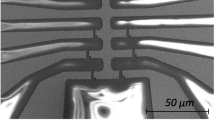Abstract
Symmetric tunneling junctions with 4000-Å-thick Pb electrodes and polycrystalline insulating barriers of Lu(OH)3, Er(OH)3, and Ho(OH)3 have been fabricated. In bulk, these three rare earth trihydroxides are nonmagnetic, antiferromagnetic (T N<1.1 K), and ferromagnetic (Tc=2.54 K), respectively. Tunneling resistances ranged from 600 to greater than 40,000 Ω with a junction area of 6.25×10−2 cm2. Single-particle tunneling characteristics of these junctions were always broadened relative to the characteristics of Pb-PbO-Pb junctions, although the ratio of the zero-bias tunneling resistance to the normal tunneling resistance in some instances was of the order of 1000. A threefold splitting of the conductance peak at the gap was observed only in junctions with Ho(OH)3 barriers. The gap peak of junctions with Er(OH)3 barriers was broadened significantly relative to that of junctions with Lu(OH)3 barriers. From measurements of the temperature and magnetic field dependences of the tunneling conductance it is argued that the splitting in junctions with Ho(OH)3 barriers is consistent with the existence of a peak in the electronic density of states at an energy below that of the gap of each of the electrodes. This peak is believed to be the signature of a bound state near the barrier where the pair potential is depressed by virtue of the exchange coupling between the spins of the superconducting electrons and the localized spins of the barrier. Qualitative interpretations of the data support the view that the observed structure in Ho(OH)3 barrier junctions is neither a consequence of intrinsic gap anisotropy in Pb nor of inelastic magnon-assisted tunnelling.
Similar content being viewed by others
References
V. L. Ginzburg,Zh. Eksp. Teor. Fiz. 31, 202 (1956) [Soc. Phys. JETP 4, 153 (1957)].
A. A. Abrikosov and L. P. Gor'kov,Zh. Eksp. Teor. Fiz. 39, 1781 (1960) [Sov. Phys. JETP 12, 1243 (1961)].
Ø. Fischer and M. B. Maple, eds.,Superconductivity in Ternary Compounds (Springer, Berlin, 1982).
C. Uher, Roy Clarke, and I. K. Schuller,Phys. Rev. B 30, 453 (1984).
G. Deutscher and P. G. de Gennes, inSuperconductivity, Vol. I, R. D. Parks, ed. (Marcel Dekker, New York, 1969), p. 1005.
P. G. de Gennes,Phys. Lett. 23, 10 (1966).
J. J. Hauser,Phys. Rev. 164, 558 (1967); J. J. Hauser, H. C. Theuerer, and N. R. Werthamer,Phys. Rev. 142, 118 (1966); G. Deutscher and F. Meunier,Phys. Rev. Lett. 22, 395 (1969).
A. M. Goldman, C. G. Kuper, and O. T. Valls,Phys. Rev. Lett. 52, 1340 (1984).
A. H. Silver and J. E. Zimmermann,Appl. Phys. Lett. 10, 142 (1967).
A. L. Belyanin, V. A. Zhikharev, and A. R. Kessel,Zh. Eksp. Teor. Fiz. 79, 1850 (1980) [Sov. Phys. JETP 53, 935 (1980)]; A. L. Belyanin, A. R. Kessel, and V. A. Zhikarev,J. Phys. C 15, 6021 (1982).
K. Baberschke and S. E. Barnes,J. Phys. C 10, 2865 (1977).
K. Baberschke, K. Bures, and S. E. Barnes,Phys. Rev. Lett. 53, 99 (1984).
D. C. Tsui, R. E. Deitz, and L. R. Walker,Phys. Rev. Lett. 27, 1729 (1971).
F. E. Stageberg, R. Cantor, A. M. Goldman, and G. B. Arnold,Phys. Rev. B, to be published.
E. L. Wolf and G. B. Arnold,Phys. Rep. 91, 31 (1982), and references therein.
Hiroyuki Shiba,Prog. Theor. Phys. 40, (1968); R. Kummel,Phys. Rev. B 6, 2617 (1972).
P. G. de Gennes,Superconductivity of Metals and Alloys (Benjamin, New York, 1966).
P. Pincus,Phys. Rev. 158, 346 (1967).
G. B. Arnold, private communication.
J. L. Bostock and M. L. A. MacVicar, inAnisotropy Effects in Superconductors, H. W. Weber, ed. (Plenum Press, New York, 1977), p. 213, and references therein.
P. Holzer, J. Keller, and P. Fulde,J. Low Temp. Phys. 14, 247 (1974).
G. T. K. Swami, F. E. Stageberg, and A. M. Goldman,J. Vac. Sci. Technol. A 2, 767 (1984).
C. A. Catanese and H. E. Meissner,Phys. Rev. B 8, 2060 (1973).
W. P. Wolf, private communication.
W. L. McMillan and J. M. Rowell, inSuperconductivity, Vol. I, R. D. Parks, ed. (Marcel Dekker, New York, 1969), p. 561.
Y. Goldstein,Phys. Lett. 12, 169 (1964).
G. I. Rochlin,Phys. Rev. 153, 513 (1967).
P. W. Anderson,J. Phys. Chem. Solids 11, 26 (1956); D. Markowitz and L. P. Kadanoff,Phys. Rev. 131, 563 (1963).
D. Rainer and G. Bergmann,J. Low Temp. Phys. 14, 501 (1974).
J. M. Freidt, G. K. Shenoy, and B. D. Dunlap,J. Phys. (Paris)40, C2–243 (1979).
A. F. Andreev,Zh. Eksp. Teor. Fiz. 46, 1823 (1964) [Sov. Phys. JETP 19, 1228 (1964)].
J. Bardeen, R. Kummel, A. E. Jacobs, and L. Tewordt,Phys. Rev. 187, 556 (1969); R. Kummel,Phys. Rev. B 3, 784 (1971); C.-R. Hu,Phys. Rev. B 12, 3635 (1975); G. Eilenberger and A. E. Jacobs,J. Low Temp. Phys. 20, 479 (1975).
B. Bar-Sagi and C. G. Kuper,Phys. Rev. Lett. 28, 1556 (1972);J. Low Temp. Phys. 16, 73 (1974).
R. E. Doezma, J. N. Huffaker, S. Whitmore, J. Slinkman, and W. E. Lawrence,Phys. Rev. Lett. 53, 714 (1984).
Author information
Authors and Affiliations
Rights and permissions
About this article
Cite this article
Stageberg, F.E., Cantor, R., Goldman, A.M. et al. Quasiparticle tunneling through rare earth trihydroxide barriers. J Low Temp Phys 60, 437–456 (1985). https://doi.org/10.1007/BF00681668
Received:
Issue Date:
DOI: https://doi.org/10.1007/BF00681668




